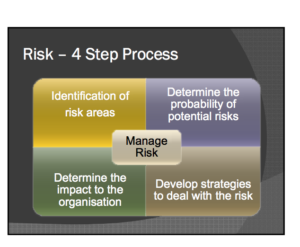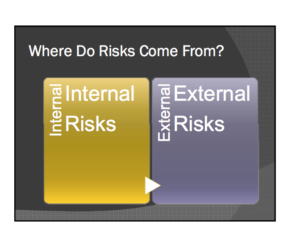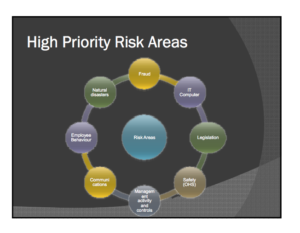If I were to ask you do you know what are the risks that could impact your practice right now, would your answer be Yes or No?
There are many risks within business, but by knowing what they are and implementing systems in place, this will provide protection to your practice.
So what is a risk and why should you manage risk within your practice?
A risk is anything that can go wrong, which will impact your practice.
All practices should examine what risks may affect the business and develop strategies to:
- deal with any problems should they occur
There are 4 basic steps to managing risk:

How to Identify Risk Areas
Where do risks come from?

Internal Areas
Certain risks may originate from within the business. These may be as a result of:
- Workplace safety
- Employee errors
- Fraud, embezzlement, product liability
- Technical or computer issues
- Business practices
External Areas
Certain risks may originate externally from the business. These may be as a result of:
- Natural disasters such as floods, hurricanes or fire
- Criminal acts such as theft, break and entry and terrorism
- Public utilities such as power failure or power surges
Every practice should review the operations and look at potential internal and external risks. These risks may be divided up into common categories or areas and plans should be developed to deal with each scenario.

Some sample risks areas:
- Natural events such as a fire sweeping through the building
- Technology such as the website goes down and it is the source of 50% of all revenue
Workplace Safety Issues
All organisations must ensure a safe working environment for their employees.
Risk can be categorised into the following areas within this category:
- Slips, trips and falls
- Emergency procedures
- Electrical
- Chemicals
- Machinery and equip
Awareness of where risk comes from is only the first step. A Risk Assessment on a regular basis is essential to prioritise all risks and the level of impact they may have within the practice i.e. high, medium and low risk.
To assist practices in being able to conduct Risk assessments, we are making available a downloadable document. Please download “How to Conduct a Risk Management Program”, which will help you establish a risk management system within your practice. This document contains checklists to help you conduct risk assessments and manage risk within your practice.
ACCESS HOW TO CONDUCT A RISK MANAGEMENT PROGRAM
How often you conduct risk assessments depends on the level of risk, the higher the risk, the more often risk assessments should be conducted. Risk assessments should also be done when any new procedures are implemented, machinery or equipment is introduced, an incident has occurred or a staff member is pregnant.



